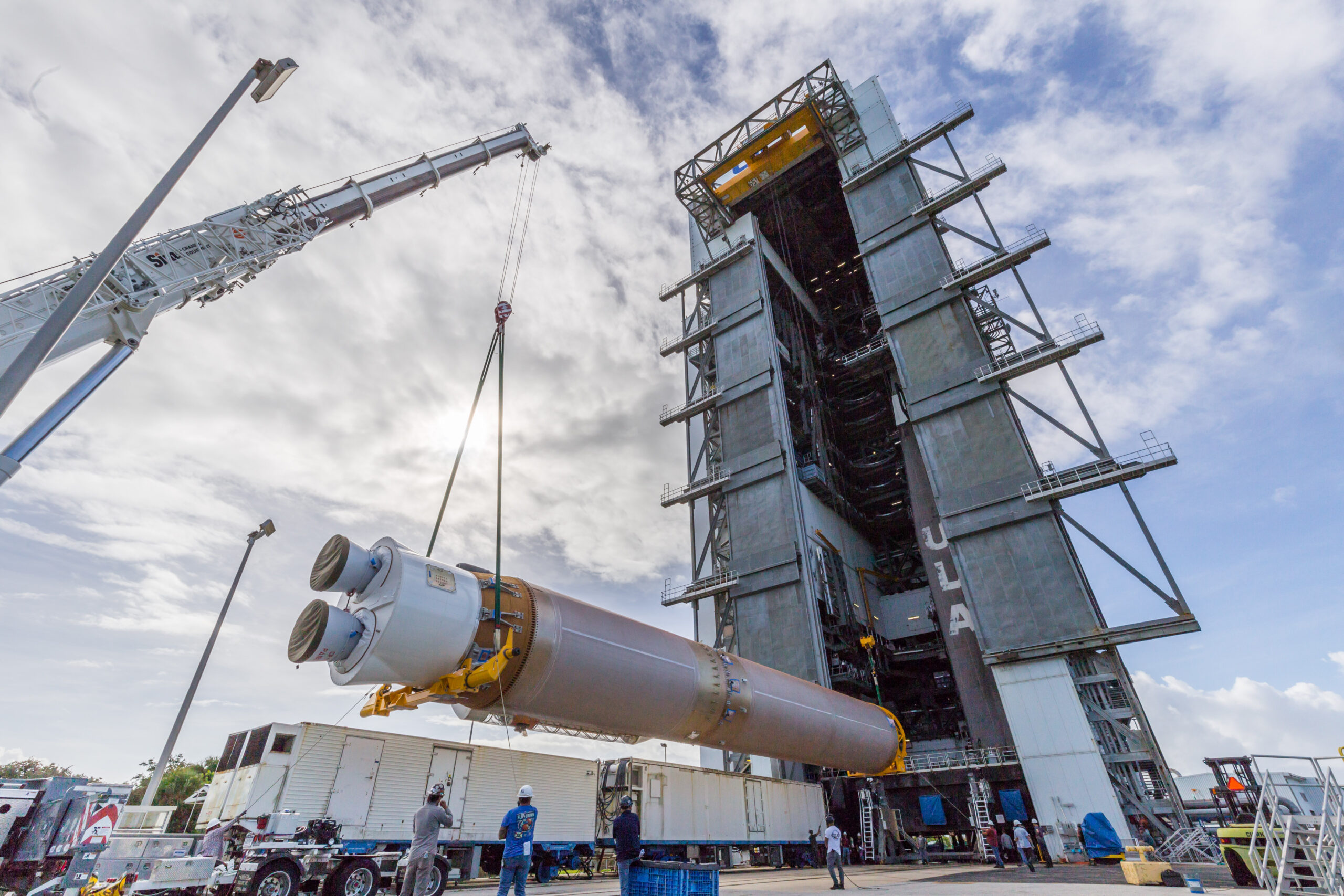Back to Article List
Here’s what’s launching from Nov. 10 to Nov. 16: A United Launch Alliance Atlas V rocket is set to launch the ViaSat-3 F2 satellite, which aims to provide over a terabit per second of broadband capacity. Other major flights include the delayed second launch of Blue Origin’s New Glenn and several Starlink launches from SpaceX.

A ULA Atlas V rocket first stage is lifted into the Vertical Integration Facility at Cape Canaveral Space Force Station, Fla., as teams prepare for the ViaSat-3 F2 satellite launch. Credit: United Launch Alliance
The United Launch Alliance (ULA) Atlas V 551 rocket is scheduled to launch the ViaSat-3 F2 satellite on November 13 from Cape Canaveral, following a prior scrub attributed to an Atlas V booster liquid oxygen tank vent valve anomaly.
ViaSat-3 F2 is the second satellite in a geostationary constellation designed to provide global internet services, with this launch serving as a critical test for corrective actions implemented to address a major deployable antenna reflector failure experienced by the preceding ViaSat-3 F1.
Beyond the ViaSat-3 mission, the current week’s launch manifest includes multiple SpaceX Starlink deployments, Blue Origin’s second New Glenn rocket flight carrying NASA’s ESCAPADE probes destined for Mars, and a suborbital test flight by Rocket Lab as part of its HASTE program.
The preceding week saw significant global launch activity from entities including Europe, Rocket Lab, China—which debuted its Long March 12 rocket—and numerous SpaceX Starlink missions, with a similarly active schedule projected for the subsequent week.
Mission Highlight: ULA Atlas V to launch 1-terabit ViaSat-3 satellite
This week’s highlight is the launch of the ViaSat-3 F2 satellite on a powerful United Launch Alliance (ULA) Atlas V 551 rocket. The launch is scheduled for Thursday, Nov. 13, from Space Launch Complex 41 (SLC-41) at Cape Canaveral Space Force Station, Florida, at 10:00 p.m. EST. The mission was scrubbed last week due to a recurring “issue with the Atlas V booster liquid oxygen tank vent valve,” according to ViaSat.
This satellite is the second of three in the ViaSat-3 constellation, which will operate from geostationary orbit, about 22,236 miles above the Earth. Unlike constellations such as Starlink, which use thousands of low-orbit satellites, Viasat’s system uses just three massive 7-ton (6,400 kg) satellites to provide coverage. These satellites can direct their bandwidth to specific high-demand areas as needed, such as focusing on a busy airport or a particular shipping lane. The system provides internet for in-flight Wi-Fi on commercial and business planes, ships at sea, government and defense operations, and home internet, particularly in rural areas.
This launch is critical for Viasat. The first satellite, ViaSat-3 F1, suffered a major deployable antenna reflector failure after its 2023 launch. This resulted in the loss of more than 90 percent of its planned 1 terabit per second capacity and a $421 million insurance claim. ViaSat-3 F2 has an antenna from the same supplier. Its launch was delayed for months to implement and test corrective actions for this deployable antenna reflector. This flight will be the first test of those fixes. The third satellite, ViaSat-3 F3, uses a different antenna and is planned to launch next year to cover the Asia-Pacific region.
The 7-ton (6,400 kg) satellite was built by Boeing. Lofting this massive payload requires the most powerful configuration of the Atlas V: the 551, which utilizes five strap-on solid rocket motors. The Atlas V is not reusable. If successful, ViaSat-3 F2 is expected to begin service over the Americas in early 2026.
Other missions this week
Monday, Nov. 10: SpaceX is scheduled to launch the Starlink Group 6-87 mission on a Falcon 9 from Cape Canaveral SFS, Florida, at 10:21 p.m. EST.
Wednesday, Nov. 12: After a weather delay last week, Blue Origin is scheduled to launch its second-ever New Glenn rocket from Cape Canaveral SFS, Florida, at 2:50 p.m. EST. This flight carries NASA’s twin ESCAPADE probes, which are destined for Mars to study its magnetosphere.
Friday, Nov. 14: SpaceX is scheduled to launch the Starlink Group 6-85 mission on a Falcon 9 from Cape Canaveral SFS, Florida, at 10:01 p.m. EST.
Friday, Nov. 14: In a separate flight, SpaceX is also scheduled to launch the Starlink Group 6-89 mission on a Falcon 9 from Kennedy Space Center, Florida, at 10:01 p.m. EST.
Sunday, Nov. 16: Rocket Lab is set to launch the Van mission on an Electron rocket from Wallops Flight Facility, Virginia, at 7:45 a.m. EST. This is a suborbital test flight as part of Rocket Lab’s HASTE (Hypersonic Accelerator Suborbital Test Electron) program.
Last week’s recap
The week of Nov. 3–Nov. 9 was busy, even with the two main US heavy-lift launches (New Glenn and Atlas V) slipping into this week. The highlights included Europe’s launch of the Sentinel-1D radar satellite on an Ariane 62 (Nov. 4) and Rocket Lab’s “The Nation God Navigates” (QPS-SAR-14) mission from New Zealand (Nov. 5). China had a very active week with four launches: a Long March 11H (Nov. 8), a Kinetica 1 (Nov. 8), a Ceres 1 (Nov. 9), and the debut flight of the new Long March 12 rocket (Nov. 9). SpaceX also had a packed schedule, launching three separate Starlink missions (Group 11-14, 6-81, and 10-51) from both coasts.
Looking ahead
Next week, launch fans can look forward to a busy schedule. The week kicks off just after midnight on Monday, Nov. 17, with SpaceX launching the Sentinel-6B sea-level monitoring satellite from California. SpaceX continues its cadence on Tuesday, Nov. 18, with a Starlink Group 6-94 mission from Florida, followed by a Starlink Group 11-30 launch from California on Wednesday, Nov. 19. Saturday, Nov. 22, features two launches: South Korean startup Innospace is scheduled to launch the “Spaceward” mission from Brazil, and SpaceX is set to launch its dedicated Transporter-15 rideshare mission from Vandenberg.

